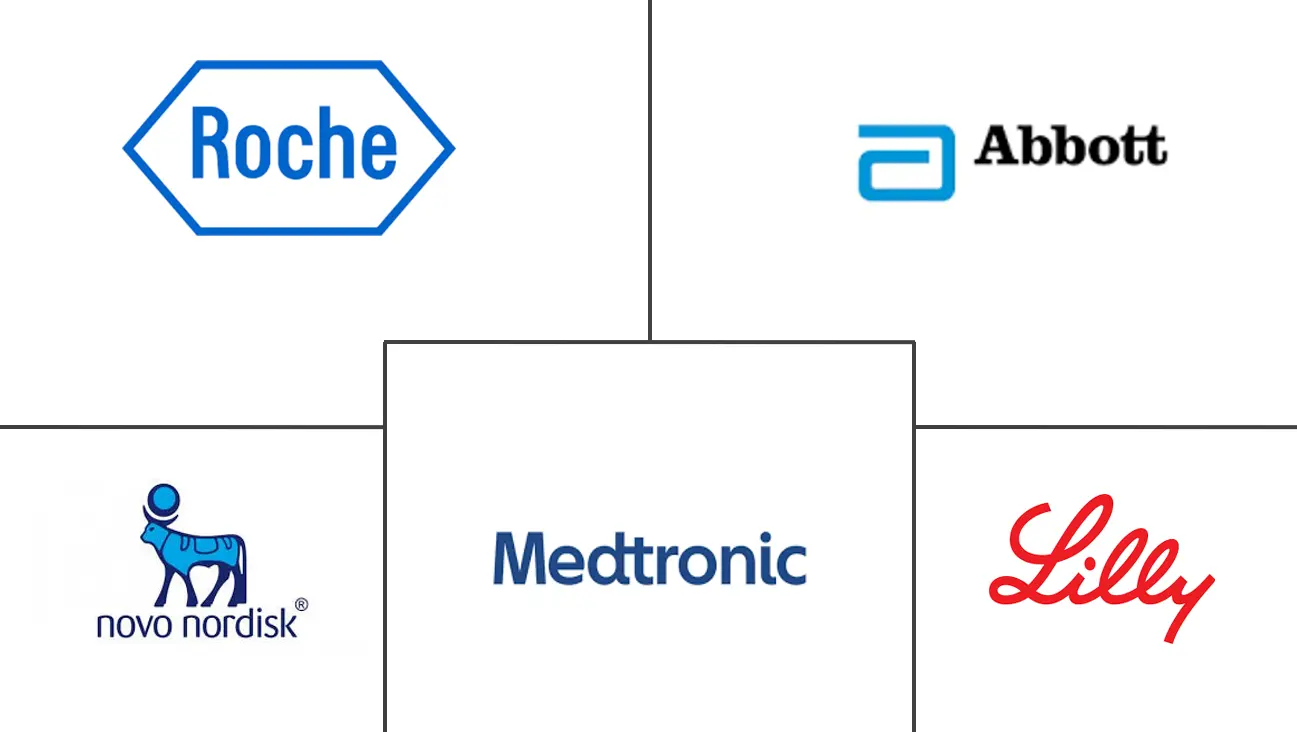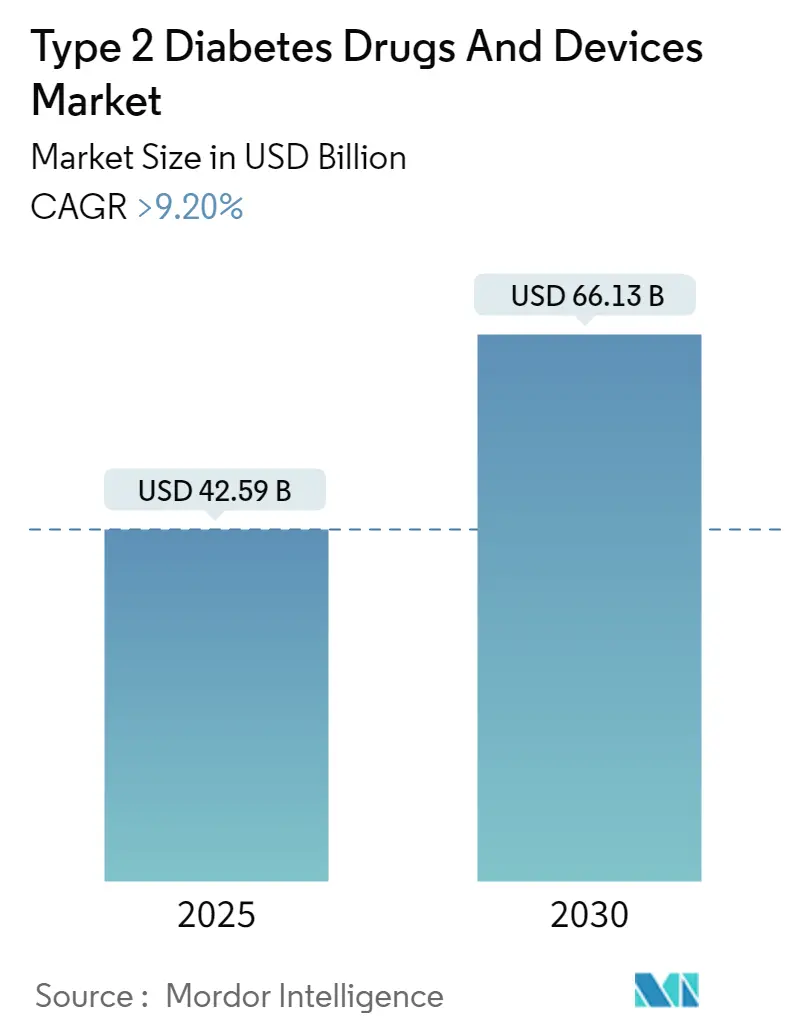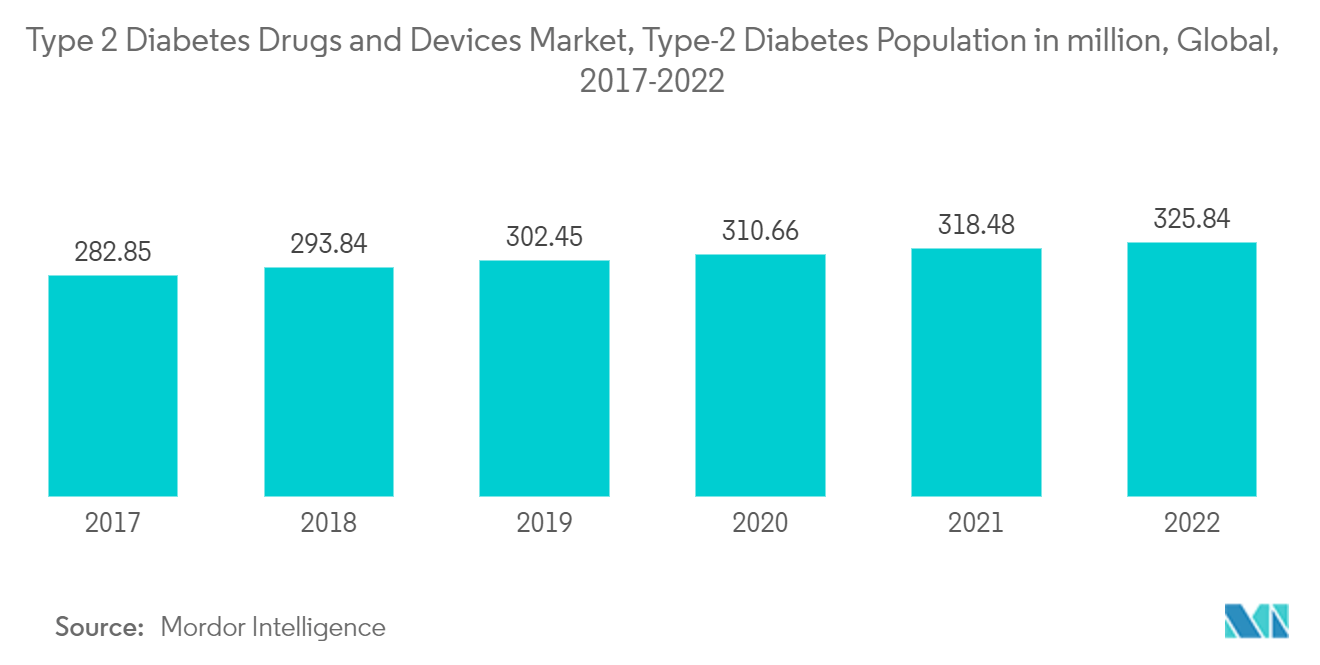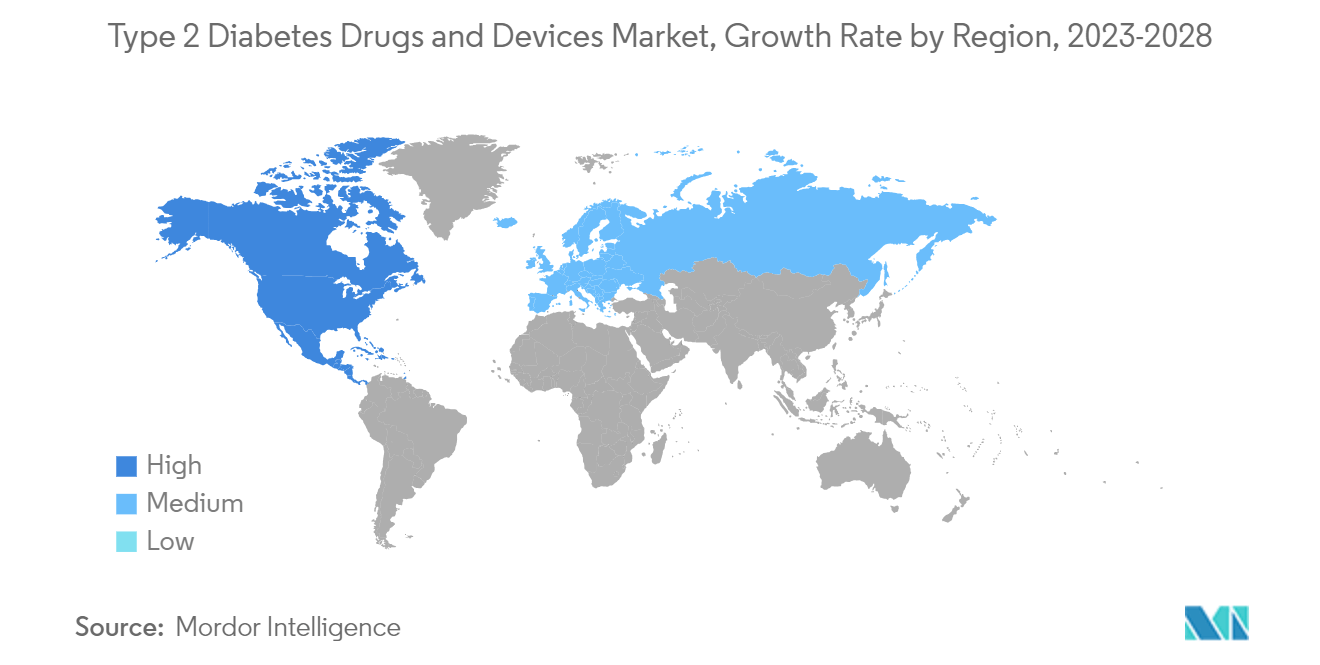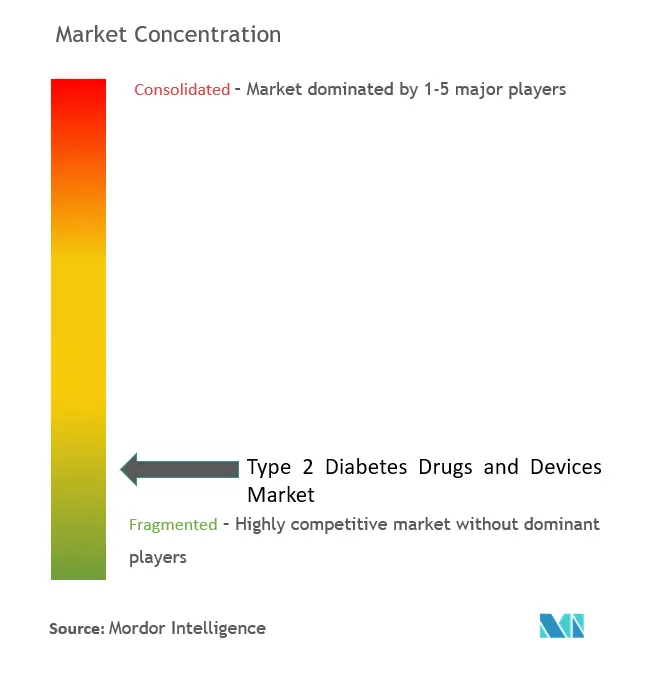Type 2 Diabetes Drugs And Devices Market Analysis
The Type 2 Diabetes Drugs And Devices Market size is estimated at USD 42.59 billion in 2025, and is expected to reach USD 66.13 billion by 2030, at a CAGR of greater than 9.2% during the forecast period (2025-2030).
People with diabetes mellitus had a greater risk of contracting COVID-19 infection. Type 2 diabetes mellitus patients had increased chances of pulmonary damage following SARS-COV-2 infection. The hyperglycemic state was an important prognostic factor in diabetic patients exposed to SARS-CoV-2. The increased severity was associated with chronic inflammation and immune system impairment in patients with Type 2 diabetes. Therefore, there was an urgent need to control elevated blood glucose control by proper monitoring and management to avoid any complications. Thus, the market continued to grow during the pandemic, offset by supply chain issues due to lockdown restrictions in various countries around the world.
Insulin is a hormone that controls blood sugar levels by signaling the liver muscle and fat cells to take in glucose from the blood. It helps cells take in glucose to be used for energy. Type 2 diabetes develops when the body does not use insulin efficiently and gradually loses the ability to make enough insulin. In type 2 diabetes, the body’s cells do not respond effectively to insulin, known as insulin resistance, which causes glucose to stay in the blood, leading to a higher-than-normal level of glucose in the blood, known as hyperglycemia.
Type 2 diabetes is a global burden disease and one of the leading causes of cardiovascular complications, which has led to the development of treatment approach options beyond insulin that also provide beneficial cardiovascular effects. The pharmacological approach has progressed from biguanides to a wide spectrum of medications that provide an additional beneficial effect. Various manufacturers are working on bringing novel antidiabetic drug classes capable of acting on several levels simultaneously.
Furthermore, various government and non-government initiatives are being launched to support patients with type 2 diabetes, which are likely to improve the awareness of patients with diabetes and, subsequently, the adoption of treatment for diabetes. For instance, the American Association of Clinical Endocrinology launched a Consensus Statement in May 2023 on a comprehensive type 2 Diabetes Management Algorithm that provides concise visual guidance in the form of algorithms to assist with clinical decision-making for the management of persons with type 2 diabetes mellitus and related comorbidities and complications. It incorporates newer therapies and management approaches that build on previous versions of the algorithm. These factors are expected to boost the market studied.
Type 2 Diabetes Drugs And Devices Market Trends
Rising obesity and diabetes prevalence over the forecast period is likely to boost the market growth
As per the International Diabetes Federation's latest estimates, about 10% of all diabetes cases are type 1, and the remaining is Type 2. The adult diabetes population is approximately 537 million, and this number is going to increase by 643 million in 2030. The rate of newly diagnosed cases of diabetes is seen to increase, mainly due to obesity, unhealthy diet, and sedentary lifestyle. Diabetes can be detected using HbA1c tests, and an appropriate treatment regimen can be implemented. In 2022, the WHO Global Diabetes Compact outlined five diabetes targets to reach by 2030, focused on addressing metabolic risks, access to medication, and diagnosis. The outlook for a healthy future is further marked by sustained progress in strategies designed to remediate diabetes through control of calorie intake, physical activity, and medication.
Oral Anti-Diabetic Drugs have been available internationally and are recommended for use when escalation of treatment for type 2 diabetes is required along with lifestyle management. Oral agents are typically the first medications used in the treatment of type 2 diabetes due to their wide range of efficacy, safety, and mechanisms of action. Antidiabetic drugs help diabetes patients to keep their condition under control and lower the risk of diabetes complications. Oral anti-diabetic agents present the advantages of easier management and lower cost, so they became an attractive alternative to insulin with better acceptance, which enhances adherence to the treatment.
Self-monitoring blood glucose devices are the most preferred device by patients due to their economic affordability and less sophisticated usage compared to CGM. The average efficiency of the glucose meter ranges between six months to three years, whereas test strips are for one-time use. The introduction of new kinds of lancet devices that induce lesser pain to the users is expected to help the market’s growth, as the acceptance rate is expected to rise during the forecast period.
Stringent government policies and favorable regulations by the WHO regarding the usage of diabetes drugs and devices are encouraging companies to develop innovative products to improve patient compliance and prevent diabetic complications.
Owing to the rising prevalence of type 2 diabetes and the factors above, it is likely that the market will continue to grow.
The Asia-Pacific region is Expected to Witness Highest Growth Rate Over the Forecast Period
In Asia-Pacific, deaths attributable to high blood glucose due to type 2 diabetes increased among lower-middle and low-income Asia-Pacific countries and territories, and about half of them are undiagnosed and unaware of developing long-term complications. According to the International Diabetes Federation's latest estimates, 90 million adults in the age group of 20-79 are living with diabetes in the Southeast Asia (SEA) Region, which is projected to increase to 113 million by 2030 and 152 million by 2045.
Countries like India and China have been recognized as potential developing markets due to the growing diabetic population in this region. These markets are associated with some challenges, like slow economic growth and increased competition. As per the National Health Commission, China has made steps to reduce diabetic patients' medical expenses by reimbursing outpatients for more than half of their medication costs. Effective strategies are needed to manage patients with diabetic complications to reduce the use of healthcare resources and economic burden. According to the National Metabolic Disease Clinical Research Center, more hospitals in China will establish National Metabolic Management Centers (MMC) as part of their exploration of a new model of diabetes treatment.
Diabetes has been identified as a healthcare priority by the Ministry of Health, Labour, and Welfare in Japan. The high prevalence of type 2 diabetes is associated with a significant economic burden. Costs increase with an increasing number of complications. Well-organized medical insurance systems cover all medical fees for diabetes mellitus, and diabetics can visit doctors freely in Japan.
The region is witnessing a significant increase in the number of generic manufacturers, and there is a growing preference for cost-effective treatment among type 2 diabetic patients, thereby giving a boost to the growth of the market studied.
Type 2 Diabetes Drugs And Devices Industry Overview
The type 2 diabetes drugs and devices market is fragmented with multiple players. Market leaders such as Eli Lilly, Sanofi, Novo Nordisk, and AstraZeneca are focusing on product launches and technological collaboration to increase their foothold in the market. Furthermore, governments all around the world are making constant efforts for the development of the type 2 diabetes market by collaborating with major market players for the launch of new products by providing subsidies to the manufacturers of type 2 diabetes drugs and medications.
Type 2 Diabetes Drugs And Devices Market Leaders
-
Abbott
-
Medtronic
-
Lilly
-
Novo Nordisk
-
Roche
- *Disclaimer: Major Players sorted in no particular order
Type 2 Diabetes Drugs And Devices Market News
- March 2023: Astellas Pharma announced that it has entered into an agreement with Roche Diabetes Care China for the development and commercialization of Roche Diabetes Care's world-renowned Accu-Chek Guide Me blood glucose monitoring system with advanced accuracy as a combined medical product with BlueStar. BlueStar is an FDA-cleared digital health solution for diabetes patients developed by Welldoc and is currently marketed in the U.S. and Canada. Astellas and Welldoc are jointly developing BlueStar in China. In the future, Astellas will aim to obtain regulatory approval and reimbursement as a combined medical product.
- March 2023: Novo Nordisk announced headline results from the PIONEER PLUS trial, a phase 3b, 68-week, efficacy and safety trial with once-daily oral semaglutide 25 mg and 50 mg versus 14 mg as an add-on to a stable dose of 1–3 oral antidiabetic medicines in people with type 2 diabetes in need of treatment intensification. The trial achieved its primary endpoint by demonstrating a statistically significant and superior reduction in HbA1c at week 52 with both the 25 mg and 50 mg doses versus the 14 mg dose of oral semaglutide.
Type 2 Diabetes Drugs And Devices Industry Segmentation
Type 2 diabetes is a condition that causes the level of sugar in the blood to become too high. The Type 2 diabetes drugs and devices market is segmented into management devices (insulin pumps, insulin syringes, insulin cartridges, disposable pens, and jet injectors), monitoring devices (self-monitoring blood glucose and continuous glucose monitoring), drugs (insulin, oral anti-diabetic drugs, non-insulin injectable drugs, and combination drugs), and geography (North America, Europe, Asia-Pacific, the Middle East and Africa, and Latin America). The report offers the value (in USD) and volume (in units) for the above segments.
| Management Devices | Insulin Pumps | ||
| Insulin Syringes | |||
| Insulin Cartridges | |||
| Disposable Pens | |||
| Jet Injectors | |||
| Monitoring Devices | Self-monitoring Blood Glucose | ||
| Continuous Glucose Monitoring | |||
| Drugs | Oral Anti-diabetic Drugs | ||
| Insulins | |||
| Combination drugs | |||
| Non-Insulin Injectable drugs | |||
| Geography | North America | United States | |
| Canada | |||
| Rest of North America | |||
| Europe | France | ||
| Germany | |||
| Italy | |||
| Spain | |||
| United Kingdom | |||
| Russia | |||
| Rest of Europe | |||
| Latin America | Mexico | ||
| Brazil | |||
| Rest of Latin America | |||
| Asia-Pacific | Japan | ||
| South Korea | |||
| China | |||
| India | |||
| Australia | |||
| Vietnam | |||
| Malaysia | |||
| Indonesia | |||
| Philippines | |||
| Thailand | |||
| Rest of Asia-Pacific | |||
| Middle East and Africa | Saudi Arabia | ||
| Iran | |||
| Egypt | |||
| Oman | |||
| South Africa | |||
| Rest of Middle East and Africa | |||
Type 2 Diabetes Drugs And Devices Market Research FAQs
How big is the Type 2 Diabetes Drugs And Devices Market?
The Type 2 Diabetes Drugs And Devices Market size is expected to reach USD 42.59 billion in 2025 and grow at a CAGR of greater than 9.20% to reach USD 66.13 billion by 2030.
What is the current Type 2 Diabetes Drugs And Devices Market size?
In 2025, the Type 2 Diabetes Drugs And Devices Market size is expected to reach USD 42.59 billion.
Who are the key players in Type 2 Diabetes Drugs And Devices Market?
Abbott, Medtronic, Lilly, Novo Nordisk and Roche are the major companies operating in the Type 2 Diabetes Drugs And Devices Market.
Which is the fastest growing region in Type 2 Diabetes Drugs And Devices Market?
Asia Pacific is estimated to grow at the highest CAGR over the forecast period (2025-2030).
Which region has the biggest share in Type 2 Diabetes Drugs And Devices Market?
In 2025, the North America accounts for the largest market share in Type 2 Diabetes Drugs And Devices Market.
What years does this Type 2 Diabetes Drugs And Devices Market cover, and what was the market size in 2024?
In 2024, the Type 2 Diabetes Drugs And Devices Market size was estimated at USD 38.67 billion. The report covers the Type 2 Diabetes Drugs And Devices Market historical market size for years: 2019, 2020, 2021, 2022, 2023 and 2024. The report also forecasts the Type 2 Diabetes Drugs And Devices Market size for years: 2025, 2026, 2027, 2028, 2029 and 2030.
Our Best Selling Reports
Type 2 Diabetes Drugs And Devices Industry Report
Statistics for the 2025 Type 2 Diabetes Drugs And Devices market share, size and revenue growth rate, created by Mordor Intelligence™ Industry Reports. Type 2 Diabetes Drugs And Devices analysis includes a market forecast outlook for 2025 to 2030 and historical overview. Get a sample of this industry analysis as a free report PDF download.

